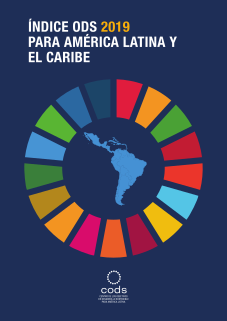More details
Executive Summary
The 2019 SDG Index for Latin America and the Caribbean presents the first comparable monitoring tool among Latin American and the Caribbean countries regarding their progress towards achieving the SDGs. The data collection, computation and report writing was led by the SDG Center for Latin America in the Caribbean (CODS) in Bogotá, Colombia, and it is based on SDSN global SDG Index initiative.
The report includes the SDG Index ranking for the region in 2019, a performance and a trend dashboard, a baseline analysis assessing the region progress since 2015, and an early effort to quantify the possible impact of the COVID-19 outbreak on the region’s SDG compliance. Each of these, emerge as a response to Latina America and the Caribbean huge challenges on measuring the official set of SDG indicators endorsed by the UN Statistical Division. The main efforts on the region has focused on self-reporting exercises like the submission of Voluntary National Reviews at UN High Level Political Forum. Although it denotes governments’ commitment with Agenda 2030, there is also a need for well-designed, timely and comparable monitoring tools to appraise the progress so far and recognize priorities for future action.
The 2019 SDG Index for Latin America and the Caribbean presents four main findings:
-
Chile, Uruguay and Costa Rica are the best performing countries in the region in the SDG Index. Even though these countries depict the greatest overall value in the Index score, fewer ‘red lights’ on the dashboards, and are comparatively better than the rest of Latina America and the Caribbean, they still face quite major challenges for achieving the SDGs. Therefore, highlighting how fall-behind is the region towards the promotion of the sustainable development agenda. The results point out that none of the 24 countries is performing as expected in order to fulfill them by 2030.
-
Lack of innovation, income inequalities and insecurity are Latin America and the Caribbean most pressing challenges. The lowest average Index scores are depicted in SDG 9 (Industry, Innovation and Infrastructure), SDG 10 (Reduced inequalities) and SDG 16 (Peace, justice and strong institutions). Besides, in these specific goals a significant proportion of the countries face major or important challenges. A relatively low public expenditure on R&D, high income inequalities and homicide rates, matched with a widespread feeling of insecurity and growing corruption are the source of it.
-
Venezuela, Argentina and Brazil show no progress in the comprehensive attainment of the 17 SDGs since it’s adoption in 2015. These impressive result stood out from the baseline analysis assessing Latin America and the Caribbean countries’ progress since the adoption of Agenda 2030, using the same set of indicators for the 2019 version of the Index. On the one side, Venezuela is the only country decreasing in the Index score due its decaying performance on SDG 1 (No poverty), SDG 2 (Zero hunger) and SDG 3 (Good health and well-being). Argentina and Brazil, on the other side, show no progress five years from the adoption of the SDGs because of a worse situation on SDG 8 (Decent work and economic growth) for the former, and SDG 16 (peace, justice and strong institutions) for the latter.
-
COVID-19 will have major adverse impacts on social and economic goals. It is the result of an early analysis on how the COVID-19 pandemic, as well as the policies to restrain it, will affect the SDGs in the short to mid term. Latin America and the Caribbean countries will likely underperform on SDG 10 (Reduced inequalities), SDG 8 (Decent work and economic growth) and SDG 1 (No poverty) from now on. Nonetheless, environmental related goals may improve for a while, but it is an opportunity, rather than something to take for granted, in the race for beating the climate crisis.
